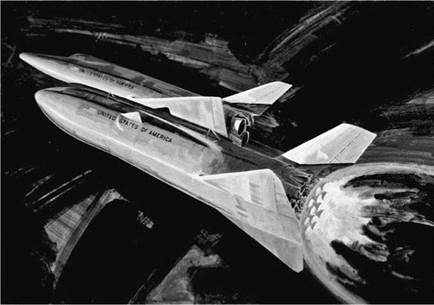Phase B Study Results
The Phase B preliminary design studies of a two-stage, fully reusable shuttle being carried out by North American Rockwell and McDonnell Douglas continued until mid-1971. There were a wide variety of orbiter and booster designs considered and cost estimates also varied widely as industry engineers struggled to meet the requirements set out by NASA. There was one
|
A 1971-vintage artist’s concept of a two-stage fully reusable space shuttle. (Illustration courtesy of Dennis Jenkins) |
constant: the shuttle designs being considered involved developing two large and expensive vehicles. For example, one version of the North American Rockwell orbiter was 206 feet long and had a wing span of 107 feet, about the size of the four-engine Boeing 707 commercial airliner then in use. The booster was 269 feet long and had a wing span of 143.5 feet, about the size of the Boeing 747 jumbo airliner then just entering commercial service; it had 12 rocket engines to provide the initial power to lift itself and the orbiter off the ground to what was called a “staging velocity.” The vehicles would then separate and the booster’s two-person crew would fly it, using a dozen air-breathing jet engines, back to a runway landing. The orbiter, also operated by a two-person crew, upon separation would fire its two engines of the same design as those used on the booster and accelerate to orbital velocity. One contractor’s estimate of the cost of a fleet of four boosters and five orbiters flying 445 missions through FY1989 was $9.6 billion.27











